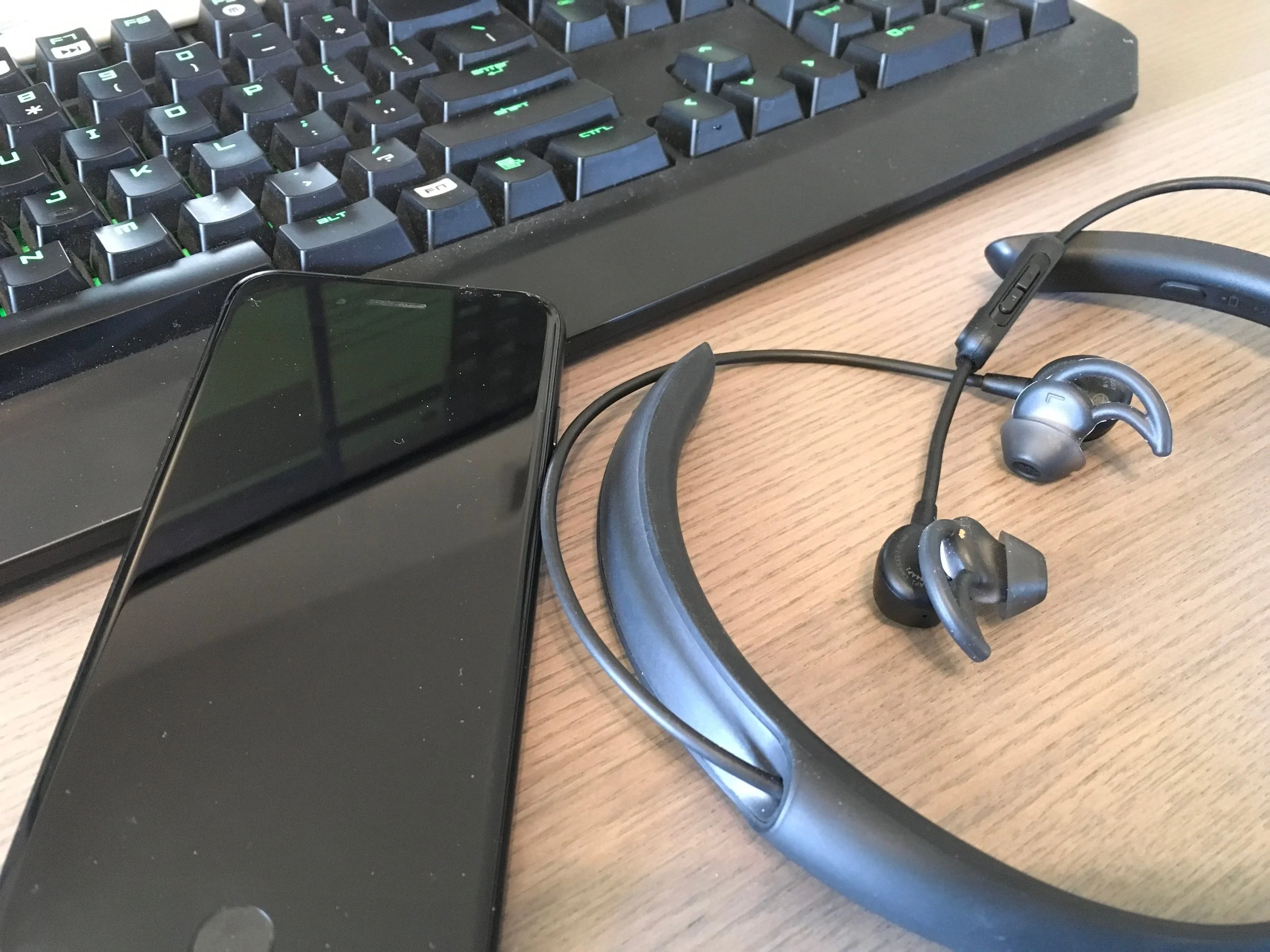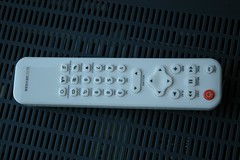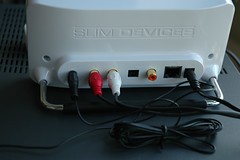Sale alert! Sennheisers are coming up with new models, and their HD218i headphones with three button Apple remote with mic headphones are on sale in many places. The "i" version used to fetch a sometimes $50 premium. Now they can be had for $39. They are great headphones for used in the office with your macs and iPads / iPhones. Or bring them with you to Starbucks as you sip expensive coffee while using their free wifi. The volume and mic control lets you adjust the volume, and use Skype. These are closed headphones which mean they do not leak sound, which is particularly important in an office environment. Sound quality? They are going to be a step up from your standard ebuds. From an audiophile point of view, they are at the lowest bearable end which is a good thing. I bought two, adding to my collections of Grado RS1 and RS2.
DAC and their chips
There are quite a lot of digital analog converters available for computer based music systems. For example, my main music source is all digital -- Apple lossless files playing thru iTunes on my iMac feeding a DAC, then a tube amp to headphones and speakers. One can debate which DAC is the best over and over. This is a table listing what chips are used in which device:
| Super Pro DAC 707 | CS8416 | CS4398 |
| Zhaolu 2.5 | n/a | CS4398 |
| Zhaolu | n/a | CS4398 |
| 7.2x | n/a | PCM1796 |
| Rush | CS8416 | PCM1796 |
| Fubar III | ?? | PCM2702 |
The CS8416 is a Receiver that supports S/PDIF input at 192kHz max. The CS4398 is a 24 bit D/A chip.
Case for the new iPod
So I have my new 3rd gen iPod Nano. I need a case. Not much choice at this point. So it's time to start a watch list:
- Apple iPod Nano Armband. Avail Now. $29.00
- Griffin Technology iClear, and Reflect, and others, Coming soon
- iSkin, none announced yet.
- ifrogz Full Body Shield $19.95, avail Now, see also Screen Shield
- ifrogz possible new product 3gnanoWrapZ, TreadZ etc, concept stage
- ezgear's ezSkins, $29.95, avail soon
new iPod Nano and Apple Marketing
I bought the new iPod Nano. It's good for travel. It's good for workout. It is half way between the shuffle and the full size iPod (classic or the other generations iPod's). I owned a first generation iPod, it was too big/heavy and lack storage. I sold it. I owned a first generation shuffle, used it for a few months, great for portability, but lack of a screen killed it for me.
The new Nano is perfect. It is a better Nano since it is actually smaller. You have to hold it, and use it, to understand the new form factor. All I need now is a case for it.
Apple Marketing? I own other Apple products. I purchased everything else online. For the Nano, I headed to a physical store to look at the colors in person and bought it there, Friday evening. I got home, and an email arrived in my email inbox, with my recent, from the store. Then I received a welcome to the iPod family email the next day. The fact that Apple managed to link the in-store purchased back to my Apple account electronically is, amazingly well done.
Squeezebox Review
Some products are truly innovative, and creates its own genre. The iPhone is one. The Squeezebox, reviewed here, is another.

What is it? The squeezebox (version 3, white) is a network music streaming device. It stream music from a music server (you supplied, see later) wirelessly or via a wired home network. You normally hook it up to your stereo to play the music. What makes it unique is that it has a flexible digital display. You use the remote and the display to control the device. There is no need for a monitor, keyboard, nor mouse.
What's the other cool stuff about it?
- it serves my Apple Lossless music tagged with Japanese and Chinese names, displayed correctly on the Squeezebox screen.
- It has optical out, which I will use later to get a even better quality audio signal
- Using the IRBlaster plugin and the $7 connector, the Squeezebox remote power my receiver on/off, and adjust its volume.
- Using different plugins, I can display other information on it -- weather, stock quotes, the last is endless
Unboxing The unit arrives in a cubish box. The items are very packed. The box is designed for easy unboxing -- I love that. The main unit is suspended in foam bookends. The accessories are in a box in the bottom. They kindly included two "finger" holes at the top of the box so that you can pull the box out of the main box easily. Good design number 1. Inside the accessory box, there is a small section that holds the remote. Again, they provided a pull-tab so that you can open that part easily. I am impressed with this company already, and I have not used the actual product yet.
Setting up the Squeezebox On power-up, the box automatically prompt you thru the setup, starting with network setup. You have to use the remote to answer questions and optionally input things like IP addresses. I always have problem with the DHCP server on my router, and I ended up having to manually enter a static IP for the squeezebox itself. And don't forget, if you have wireless LAN security like MAC filtering, you have to enable the squeezebox on your router first. The MAC address is on the label at the bottom of the unit. The entire setup should only take a few units. Again, this user interface actually works!
Setting up the Music Server The music server is a piece of software called SlimServer. It is free. You can install and run it on a Mac, a PC, a Linux box, or even some dedicated hardware (see later). Now a little bit about my music setup:
I use an iMac as my primary music machine, meaning I rip my CD using the iMac and play most of my music using iTunes on this iMac. iTunes can stream music to an Apple Airport Express. That's how I play digital music on my main audio system in the living room. I also use the iMac USB output to play music on my vacuum tube headphone amp, but that's another story.
I store all the music files in Apple Lossless format, on a network attached device (NAS) called the ReadyNAS NV+ made by Infrant Technology. They just got bought by NETGEAR. This is a pretty expensive and serious storage device. I run it in X-RAID mode, so that it is unlikely that I will lose any of my music files due to harddrive failure.
Here is the interesting part -- back to the Music Server software SlimServer. It actually runs on this NAS. So I can have the NAS feeding the Squeezebox, without any PC/Mac in between. I tried it. It works, sloooowly. I read on many online forums that this setup is slow. And it is. On top of that, the software version is also a little out of date compare to the PC/Mac based version. At the end, there are three problems with using the SlimServer on the ReadyNAS NV+:
- It is slow (and I have the 1G memory version)
- The software is a few minor version behind
- It is much harder to install plugins, and the number of plugins available is smaller
- I cannot access my iTunes playlist since it is not stored on the NAS
So I tried running SlimServer on my iMac. It is much better. It is faster. Plugins become easy. I can use my iTunes playlist. I switched over to use the Mac version.
The squeezebox has a very small external power brick. It comes with a RCA to RCA cable to connect the squeezebox to your stereo using analog signals, which is the must likely scenario. If you want to use optical out to either a independent DAC, or a receiver that has optical input, you have to supply your own cable.
IRBlaster controlling my Receiver This works amazingly well. I am using a pretty high quality NAD receiver solely for playing the squeezebox music in the bedroom. Out of all the features, I only really need to switch it on and off, and adjust it's volume. Well, using the IRBlaster plugin and the $7 LED emitter plugged into the headphone out, I can have the squeezebox remote controls the receiver directly. When I press power-on on the squeezebox, it will turn on both the squeezebox and the receiver. When I press volume up, it will turn the volume up on the receiver (instead of changing the volume on the squeezebox).
Plugins This is one of the cool thing you can do with the Squeezebox. You can download and install all sorts of plugins that enhences the use of the device. These are the ones that I use:
IRBlaster Download it here. It is described in a little detail on the slimdevices wiki. You may need to hunt down the correct IR codes from the LIRC site. It is not very user friendly but it works. Create a directory on your computer and points IRBlaster to it to load the config file.
Somewhere hidden in the documentation, it says that the volume of the squeezebox is set default to 50/100 by IRBlaster. If that is not good enough you can change it by editing the config file and restart slimserver afterwards. For me, the value 50/100 gives me reasonable output volume with my amp, and it won't play too loud which is fine for for my bedroom system.
WeatherTime The other plugin that I use is WeatherTime. It display current and forcasted weather as well as date and time on the squeezebox. It uses weather.com, and you have to go thru a little configuration, but it is worth it. You can see the screenshots and download it from its website. This replaces the simple date/time display screensaver for me when the squeezebox is off.
Audio Space Mini Galaxy I Headphone Amplifier
Listening, #3 - Comparing DAC
Today I finally got time to test out my new tube amp, a Audio Space Mini Galaxy I. First, the amp does make the K701 sounds much better. Before going into the amp's sound, I needed to decide my audio path setup. There are two main paths (with a small variation) that I can use:
1a) iMac optical Toslink out, to Presonus Central Station, main line out, to Mini Galaxy analog in. 1b) iMac optical Toslink out, to Presonus Central Station, cue line out, to Mini Galaxy analog in. 2) iMac USB out, to Mini Galaxy USB DAC in (it has a burr brown 2702 DAC)
Quick answer, 1b is the best.
At this point it is hard to see if the difference is due to the Toslink vs USB out on the iMac, or the DAC in the CS vs the DAC in the Mini Galaxy. But using one of my test track, track one on the Speaking In Strings CD by Nadja Salerno-Sonnenberg, the Swan, I can hear the string and her breathing much more clearly with option 1.
The reason of using the cue line out is that I can use the volume control on the CS to lower the output. On some tracks, the main line out from the CS is so loud that I can barely turn the volume on the amp pass "min".
Listening, #2
My K701 arrived today. This is my second serious headphone. Perhaps one can agree that this is a better set than the E500 IEM. I choose the K701 as my second pair for many reasons:
- It IS the top of the line from AKG
- It is suppose to be high on accuracy, but not great for bass and rock (I am not a heavy rock person).
- It looks distinctive
- It is particular and suited for tube amp (I have a tube amp coming).
- It is either very comfortable, or very uncomfortable, from the reviews I read
Well, it is very comfortable for me. Very low pressure. Big ear pads (circumaurual), and comfortable headband. So I am glad. All the reviews says that the K701 really need to be burnt in for 200 hours before it will shine. From the first listen I have to agree. I don't think it is better than the E500 at the moment. It has more clarity I think, but I am not sure. So between short listening session today, I am letting iTunes shuffle randomly thru my 8000 tracks to burn it in.
More to follow, obviously.
Listening, #1
Apologies to Stereophile to borrow one of their column titles. Confession - I used to be an audiophile. My audio palate is (was?) pretty good. But for the pass many years I have put the music and sound system hobby aside.
Now I am back to audiophile, the head-fi edition. Music listening via headphones. More on that later, but this evening I tried out several different configurations of equipment and found some enjoyable discoveries on my set of test tracks:
Summertime by Patricia Barber, on the Distortion of Love CD, has always been one of my fav audition track. The base on the track is so nice. Tonight I heard much more detail on the reverb on the string.
















